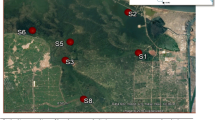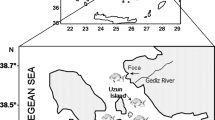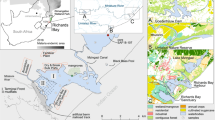Abstract
In this study we quantified and compared bioaccumulated OCPs in target fish species Cichlasoma urophthalmus (Mayan cichlid) and Oreochromis niloticus (Nile tilapia) and sediment in two lentic systems neighboring areas with different land use (Xnoha = agricultural/Mocu = nature reserve). Fish at both sites showed the same number of pesticide compounds (17) while in sediment were 17 and 20, respectively. ∑chlordane concentrations were significantly higher in Xnoha in both fish and sediment (1.0 and 0.17 µg/g, respectively). Here higher concentrations of o,p’DDT were found in fish than in sediments, this was similarly demonstrated in Mocu but to a lesser extent. The proportion of endosulfan sulfate was lower in Xnoha (<20 %) than in Mocu (<50 %) compared to the original product. Detected concentrations of ∑DDT and chlordane exceed international permissible limits. Results indicate that OCPs were present in both aquatic systems regardless of the differences in land use.




Similar content being viewed by others
References
Arnot JA, Gobas FAPC (2006) A review of bioconcentration factor (BCF) and bioaccumulation factor (BAF) assessments for organic chemicals in aquatic organisms. Environ Rev 14:257–297. doi:10.1139/A06-005
Benítez JA, Bárcenas C (1996) Patrones de uso de los plaguicidas en la zona costera del Golfo de México. In: Botello AV, Rojas GJL, Benítez J, Zarate LD (eds) Golfo de México contaminación e impacto ambiental: diagnóstico y tendencias. Epomex, Serie Científica 5, Campeche, México, pp 155–167
Bergman A, Heindel JJ, Jobling S, Kidd KA, Zoeller RT (2013) State of the science of endocrine disrupting chemicals—2012. Geneva UNEP/WHO
Burton GA (2002) Sediment quality criteria in use around the World. J Limno 3:65–75
Chopra AK, Sharma MK, Chamoli S (2011) Bioaccumulation of organochlorine pesticides in aquatic systems—an overview. Environ Monit Assess 173(1):905–916
Chung EG, Bombardelli FA, Schladow SG (2009) Sediment resuspension in a shallow lake. Wat Resour Res 45:W05422. doi:10.1029/2007WR006585
Fiener P, Auerswald K, Van Oost K (2011) Spatio-temporal patterns in land use and management affecting surface runoff response of agricultural catchments—a review. Earth Sci Rev 106:92–104. doi:10.1016/j.earscirev.2011.01.004
Food and Agriculture Organization (FAO) (1999) Codex alimentarius, pesticides residues in food, maximum residues limits, vol 2B, 2nd edn
Hinojosa-Garro D, Retana O, Rendon von Osten J, Vargas J, Padilla S (2011) Calidad de agua y presencia de contaminantes orgánicos persistentes en fauna terrestre y acuática en dos sistemas lénticos del estado de Campeche: evaluación y determinación de posibles grupos indicadores. Informe Final, FOMIX-Campeche
Hinojosa-Garro D, Arceo-Gómez J, Zambrano L, Escalera-Vásquez LH (2013) Fish diet composition in permanent and semi-permanent pools in tropical wetlands of the Yucatan Peninsula. Neotrop Ichthyol. doi:10.1590/S1679-62252013000400016
INEGI (2005) http://sc.inegi.org.mx/cobdem/contenido.jsp
Katagi T (2006) Behavior of pesticides in water-sediment systems. Environ Contam Toxicol 187:133–251. doi:10.1007/978-1-4419-1440-8_1
Lara-Domínguez AL, Villalobos-Zapata GJ, Rivera-Arriaga E (1990) Catálogo bibliográfico de la región de la Sonda de Campeche. SEP–Univ. Autónoma de Campeche. Epomex Serie Científica 1
Lopez-Carrillo L, Torres-Arreola L, Torres-Sanchez L, Espinosa- Torres F, Jimenez C, Cebrian M, Waliszewski S, Saldate O (1996) Is DDT use a public health problem in Mexico? Environ Health Perspect 104:584–588
Martínez-Palacios CA, Ross LG (1994) Biología y cultivo de la mojarra latinoamericana: Cichlasoma urophthalmus. Consejo Nacional de Ciencia y Tecnología/Centro de Investigación para la Alimentación y el Desarrollo, México
Mckinney MA, Iverson SJ, Fisk AT, Sonne C, Rig FF, Letcher RJ, Arts MT, Born EW, Rosing-Asvid A, Ietz RD (2013) Global change effects on the long-term feeding ecology and contaminant exposures of East Greenland polar bears. Glob Change Biol. doi:10.1111/gcb.12241
Moiseenko TI (2008) Aquatic ecotoxicology: theoretical principles and practical application. Water Resour 35(5):530–541. doi:10.1134/S0097807808050047
Muir DGC, Norstrom RJ, Simon M (1988) Organochlorine contaminants in arctic marine food chains: accumulation of specific polychlorinated biphenyls and chlordane-related compounds. Environ Sci Technol 22(9):1071–1079
Palma P, Palma VL, Fernandes RM, Soares AMVM, Barbosa IR (2008) Endosulfan sulphate interferes with reproduction, embryonic development and sex differentiation in Daphnia magna. Ecotox Environ Safe 72(2):344–350. doi:10.1007/s00128-008-9517-3
Peterson SM, Batley GE (1993) The fate of endosulfan in aquatic ecosystems. Environ Pollut 82:143–152
Rendón von Osten J, González M, Memije M, Quetz L (2008) Contaminantes persistentes en el valle de Yohaltún y el río Champotón, Campeche. Jaina 19(1):4–10
Scheffer M (2004) The ecology of shallow lakes. Kluwer Academic Publisher, New York
Schwarenbach RP, Escher BI, Fenne K, Hoffstetter TB, Johnson CA, von Gunten U, Wehrli B (2006) The challenge of micropollutants in aquatic systems. Science 313:1072–1077. doi:10.1126/science.1127291
Shivaramaiah HM, Sanchez-Bayo F, Al-Rifai J, Kennedy IR (2005) The fate of endosulfan in water. J Environ Sci Heal B 40:711–720
Suedel B, Boraczek J, Peddicord R, Clifford P, Dillon T (1994) Trophic transfer and biomagnification potential of contaminants in aquatic ecosystems. Rev Environ Contam Toxicol 136:21
van der Oost R, Beyer J, Vermeulen NPE (2003) Fish bioaccumulation and biomarkers in environmental risk assessment: a review. Environ Toxicol Phar 13:57–149
Wang P, Zhang Q, Wang Y, Wang T, Li X, Ding L, Jiang G (2010) Evaluation of Soxhlet extraction, accelerated solvent extraction and microwave-assisted extraction for the determination of polychlorinated biphenyls and polybrominated diphenyl ethers in soil and fish samples. Anal Chim Acta 663:43–44. doi:10.1016/j.aca.2010.01.035
Acknowledgments
We are thankful to Miguel Colorado and Nayarit the Castellot authorities for allowing us to carried out fieldwork. This study was sponsored by CONACyT, FOMIX-Campeche, as part of the project Calidad de agua y presencia de contaminantes orgánicos persistentes en fauna terrestre y acuática en dos sistemas lénticos del estado de Campeche: evaluación y determinación de posibles grupos indicadores, Grant No. FOMIX-2008-C01-96368. We would also like to thank Dr. Robin Soper for his valuable comments on our manuscript, Martin Memije for the technical assistance in the laboratory, as well as Karol Arcique Córdoba for providing the study area map.
Author information
Authors and Affiliations
Corresponding author
Rights and permissions
About this article
Cite this article
Hinojosa-Garro, D., Burgos Chan, A.M. & Rendón-von Osten, J. Organochlorine Pesticides (OCPs) in Sediment and Fish of Two Tropical Water Bodies Under Different Land Use. Bull Environ Contam Toxicol 97, 105–111 (2016). https://doi.org/10.1007/s00128-016-1828-1
Received:
Accepted:
Published:
Issue Date:
DOI: https://doi.org/10.1007/s00128-016-1828-1




